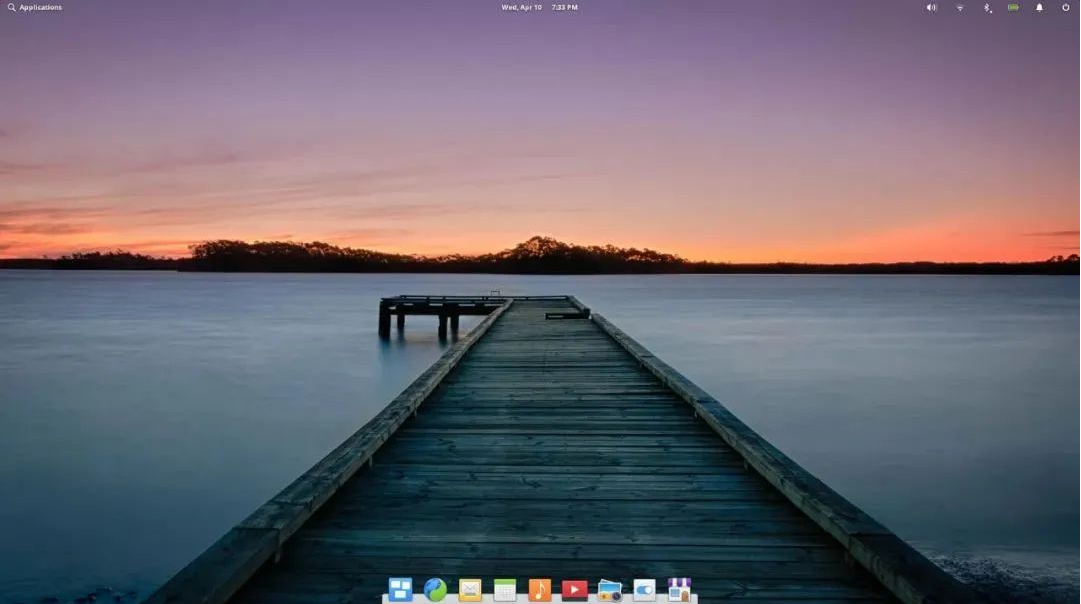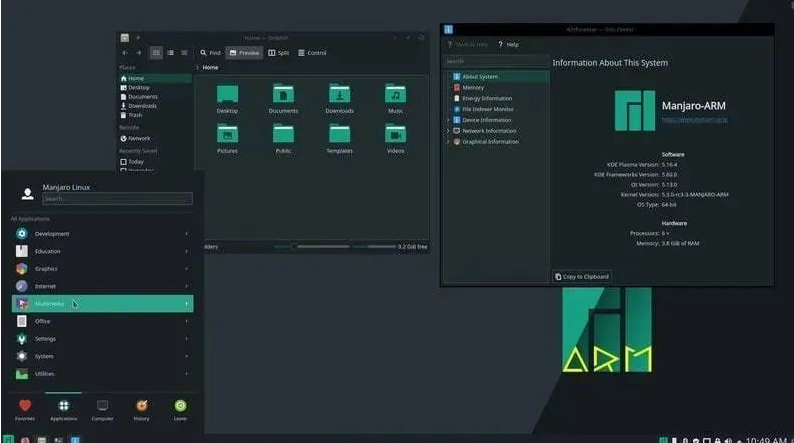7 beautiful Linux operating systems!
There are many Linux distributions. Here are 7 beautiful Linux distributions, which can be said to be the most beautiful ones in the Linux operating system world.
elementary OS

Website: https://elementaryos.cn
elementary OS operating system is one of the most beautiful Linux distributions. It is based on the macOS look and feel while providing Linux users with an excellent user experience. If the user is already accustomed to using macOS, there will be no problem using elementary OS.
In addition, elementary OS operating system is based on Ubuntu, so users can also easily find a large number of applications to complete tasks.
elementary OS is not only limited to appearance, but also constantly improving. Therefore, the user experience improves with every update.
Deepin
Website: https://www.deepin.org
Deepin is another beautiful Linux distribution, originally based on the stable branch of Debian. The animation (appearance) can be a little overwhelming - but it looks beautiful.
It has its own Deepin desktop environment, which contains a variety of basic functions for the best user experience. It may not be exactly similar to any other distribution's UI, but it's relatively easy to get used to.
Pop!_OS
Website: https://system76.com/pop
Pop!_OS manages to provide a great UI on Ubuntu while delivering a pure GNOME experience. Although Pop!_OS is neither flashy nor does it include fancy animations, it solves problems through a perfect combination of icons/themes while improving the user experience from a technical perspective.
Manjaro

Website: https://manjaro.org
Manjaro Linux is an Arch-based Linux distribution. Although installing Arch Linux is a slightly more complicated task, Manjaro offers an easier and smoother Arch experience.
It provides a variety of desktop environment versions for users to choose from when downloading. No matter what they choose, users still get enough options to customize the look and layout.
KDE Neon

Website: https://neon.kde.org
KDE Neon is for users who want to simplify their approach to design language but still get a great user experience.
This is a lightweight Linux distribution based on Ubuntu. As the name suggests, it has a KDE Plasma desktop and looks very nice.
KDE Neon provides the latest and greatest KDE Plasma desktop and KDE applications. Unlike Kubuntu or other KDE-based distributions, users don't have to wait months to get new KDE software. In addition, users can also get many built-in customization options on the KDE desktop.
Zorin OS

Website: https://zorinos.com
Zorin OS is an impressive Linux distribution that offers a good user experience even in its stripped-down version.
Users can try the full version or the lite version (using Xfce desktop). The UI is tailor-made for Windows and macOS users. Although based on Ubuntu, it provides a great user experience.
If users start with its user interface, they can try Zorin Grid to manage multiple computers running Zorin OS in the workplace/home. If using the Ultimate version, users can also control the layout of their desktop.
Nitrux OS
Website: https://nxos.org
Nitrux OS is a unique representation of a Linux distribution that is somewhat based on Ubuntu, but not entirely based on Ubuntu.
It focuses on providing a great user experience for users who are looking for a unique design language and a fresh take on Linux distributions, using the KDE-based Nomad desktop.
Nitrux encourages the use of AppImage for applications. But users can also use Arch Linux’s pacman package manager with Ubuntu-based Nitrux.
The above is the detailed content of 7 beautiful Linux operating systems!. For more information, please follow other related articles on the PHP Chinese website!

Hot AI Tools

Undresser.AI Undress
AI-powered app for creating realistic nude photos

AI Clothes Remover
Online AI tool for removing clothes from photos.

Undress AI Tool
Undress images for free

Clothoff.io
AI clothes remover

AI Hentai Generator
Generate AI Hentai for free.

Hot Article

Hot Tools

Notepad++7.3.1
Easy-to-use and free code editor

SublimeText3 Chinese version
Chinese version, very easy to use

Zend Studio 13.0.1
Powerful PHP integrated development environment

Dreamweaver CS6
Visual web development tools

SublimeText3 Mac version
God-level code editing software (SublimeText3)

Hot Topics
 1378
1378
 52
52
 How to start apache
Apr 13, 2025 pm 01:06 PM
How to start apache
Apr 13, 2025 pm 01:06 PM
The steps to start Apache are as follows: Install Apache (command: sudo apt-get install apache2 or download it from the official website) Start Apache (Linux: sudo systemctl start apache2; Windows: Right-click the "Apache2.4" service and select "Start") Check whether it has been started (Linux: sudo systemctl status apache2; Windows: Check the status of the "Apache2.4" service in the service manager) Enable boot automatically (optional, Linux: sudo systemctl
 What to do if the apache80 port is occupied
Apr 13, 2025 pm 01:24 PM
What to do if the apache80 port is occupied
Apr 13, 2025 pm 01:24 PM
When the Apache 80 port is occupied, the solution is as follows: find out the process that occupies the port and close it. Check the firewall settings to make sure Apache is not blocked. If the above method does not work, please reconfigure Apache to use a different port. Restart the Apache service.
 How to monitor Nginx SSL performance on Debian
Apr 12, 2025 pm 10:18 PM
How to monitor Nginx SSL performance on Debian
Apr 12, 2025 pm 10:18 PM
This article describes how to effectively monitor the SSL performance of Nginx servers on Debian systems. We will use NginxExporter to export Nginx status data to Prometheus and then visually display it through Grafana. Step 1: Configuring Nginx First, we need to enable the stub_status module in the Nginx configuration file to obtain the status information of Nginx. Add the following snippet in your Nginx configuration file (usually located in /etc/nginx/nginx.conf or its include file): location/nginx_status{stub_status
 How to set up a recycling bin in Debian system
Apr 12, 2025 pm 10:51 PM
How to set up a recycling bin in Debian system
Apr 12, 2025 pm 10:51 PM
This article introduces two methods of configuring a recycling bin in a Debian system: a graphical interface and a command line. Method 1: Use the Nautilus graphical interface to open the file manager: Find and start the Nautilus file manager (usually called "File") in the desktop or application menu. Find the Recycle Bin: Look for the Recycle Bin folder in the left navigation bar. If it is not found, try clicking "Other Location" or "Computer" to search. Configure Recycle Bin properties: Right-click "Recycle Bin" and select "Properties". In the Properties window, you can adjust the following settings: Maximum Size: Limit the disk space available in the Recycle Bin. Retention time: Set the preservation before the file is automatically deleted in the recycling bin
 How to restart the apache server
Apr 13, 2025 pm 01:12 PM
How to restart the apache server
Apr 13, 2025 pm 01:12 PM
To restart the Apache server, follow these steps: Linux/macOS: Run sudo systemctl restart apache2. Windows: Run net stop Apache2.4 and then net start Apache2.4. Run netstat -a | findstr 80 to check the server status.
 How to optimize the performance of debian readdir
Apr 13, 2025 am 08:48 AM
How to optimize the performance of debian readdir
Apr 13, 2025 am 08:48 AM
In Debian systems, readdir system calls are used to read directory contents. If its performance is not good, try the following optimization strategy: Simplify the number of directory files: Split large directories into multiple small directories as much as possible, reducing the number of items processed per readdir call. Enable directory content caching: build a cache mechanism, update the cache regularly or when directory content changes, and reduce frequent calls to readdir. Memory caches (such as Memcached or Redis) or local caches (such as files or databases) can be considered. Adopt efficient data structure: If you implement directory traversal by yourself, select more efficient data structures (such as hash tables instead of linear search) to store and access directory information
 How to solve the problem that apache cannot be started
Apr 13, 2025 pm 01:21 PM
How to solve the problem that apache cannot be started
Apr 13, 2025 pm 01:21 PM
Apache cannot start because the following reasons may be: Configuration file syntax error. Conflict with other application ports. Permissions issue. Out of memory. Process deadlock. Daemon failure. SELinux permissions issues. Firewall problem. Software conflict.
 How debian readdir integrates with other tools
Apr 13, 2025 am 09:42 AM
How debian readdir integrates with other tools
Apr 13, 2025 am 09:42 AM
The readdir function in the Debian system is a system call used to read directory contents and is often used in C programming. This article will explain how to integrate readdir with other tools to enhance its functionality. Method 1: Combining C language program and pipeline First, write a C program to call the readdir function and output the result: #include#include#include#includeintmain(intargc,char*argv[]){DIR*dir;structdirent*entry;if(argc!=2){




